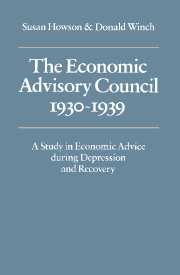5 - THE COMMITTEE ON ECONOMIC INFORMATION 1932–9
Published online by Cambridge University Press: 07 October 2011
Summary
The bottom of the depression was reached in 1932. Recovery began in the autumn when the housing boom, which was the most conspicuous feature of Britain's recovery, got under way. The recovery period lasted for five years; in late 1937 the American recession of that year spread to Britain, but its effects were soon countered by rearmament expenditure, which began to exert a substantial impact on the economy in 1938. How far the post-goldstandard policy changes in 1931 and 1932 were responsible for recovery has been a subject of debate ever since. Although the depreciation of sterling arrested the decline, it did not result in a significant rise in exports; the staple export trades remained depressed for most of the 1930s. Depreciation and the tariff substantially reduced imports but the big fall came late in 1932, after the beginning of recovery. A small post-‘devaluation’ burst of activity in the iron and steel and textile trades soon petered out. Although investment in iron and steel was encouraged by the tariff, most of the large posttariff increases came in 1934 when the tariff was made permanent. In the meantime housebuilding had risen by 70 per cent, and the strongest explanation for recovery is that the introduction of cheap money set off the housing boom, and once employment began to rise in 1933, other factors, such as increased investment in the newer industries, operated to reinforce the expansion of output and employment.
- Type
- Chapter
- Information
- The Economic Advisory Council, 1930–1939A Study in Economic Advice during Depression and Recovery, pp. 106 - 153Publisher: Cambridge University PressPrint publication year: 1977
- 1
- Cited by



